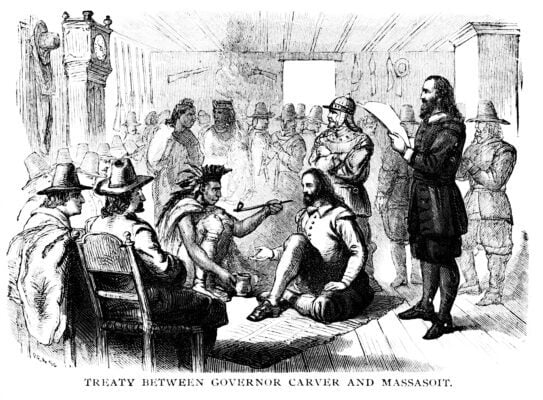In the United States, three powerful myths — the story of Columbus discovering America, the First Thanksgiving, and the Southern Strategy — have done more than shape our understanding of history. They’ve constructed a picture of power. Each was a strategic invention, designed to make domination look like destiny, violence sound like virtue, and inequality feel like heritage.
As 2025 draws to an end and particularly as we enter into a season of Thanksgiving, I reflect on our country’s history and what it took to get us “here.” Here is a time of chaos and confusion. Historically, the United States has strategically constructed stories that cast it as a bright light. Looking back at these three pivotal myths may reveal how we got here — and how we move forward. It’s time to be just as strategic in our truth-telling as those who built the lies.
The Columbus myth: Inventing legitimacy
The story goes that a brave explorer “discovered” a new world and opened the path to civilization. But that tale of discovery is really a story of erasure. Indigenous peoples had lived across the Americas for tens of thousands of years, building vast, complex societies. By calling their lands “discovered,” Europe declared them empty, available, and waiting to be claimed.
That was no accident. The Columbus myth transformed invasion into heroism, conquest into progress, and genocide into God’s plan.

Its strategic function was clear: to legitimize colonization and to tell the world that history began when Europeans arrived — and everyone else was merely “found.”
The Thanksgiving myth: Inventing innocence
Fast-forward to 1621 and a familiar image: Pilgrims and Native Americans sitting together in gratitude and peace, the supposed birth of American friendship and faith. But the real story is far more complex — and far more revealing.
The Wampanoag people, led by Massasoit, joined the feast not as honored guests but as concerned neighbors. Hearing gunfire from the settlers, they came to investigate, not to celebrate. Their nation had been ravaged by a European-borne epidemic. That gathering was not a religious celebration and did not mark the start of lasting peace. Within decades, the alliance collapsed in war and blood.
Two centuries later, in 1863, Abraham Lincoln declared Thanksgiving a national holiday in the midst of the Civil War. His goal was to unify a fractured nation under a shared, moral story. The myth of peaceful coexistence became a symbol of national virtue.
Thanksgiving, then, was not simply a holiday — it was a strategic cleansing of colonial guilt. It taught that America’s beginnings were humble, cooperative, and blessed by God — not built on displacement and genocide. It gave the young nation a way to love itself without confronting the cost of its existence.

The Southern Strategy: Inventing division
If Columbus created legitimacy and Thanksgiving created innocence, the Southern Strategy created control.
After the Civil Rights Movement dismantled Jim Crow laws in the 1960s, political strategists faced a challenge: how to preserve white political power in a newly desegregated America. The answer was familiar — change the story.
Instead of open racism, they spoke of “states’ rights,” “law and order,” and “family values.” Confederate symbols were rebranded as “heritage.” Economic inequality became “personal responsibility.” Racial resentment was coded as patriotism.
Perfected by Nixon and Reagan, this strategy redefined who “real Americans” were — and who was taking their country away. It didn’t just divide; it mythologized division, convincing millions that protecting privilege was defending freedom.
The architecture of American myth
Together, these three stories form a continuum built on the power of mythical narrative.
The Columbus myth justifies colonization and builds false pride in America’s origins.
The Thanksgiving myth paints a picture of innocence, gratitude, and harmony.
The Southern Strategy preserves racial power and stokes fear and nostalgia among a chosen few.
Together, they create the illusion of a moral nation.
A call for strategic truth
It’s not enough to correct these myths with facts. We must be as strategic in truth-telling as those who built the lies. We need stories that restore belonging through accountability — stories that honor survival, complexity, and resistance.
Our counter-narratives must do what theirs did: move hearts, shape identity, and make justice feel like destiny.
I stand on the African proverb: Until the Lion tells the story, the hunter is always the hero. Now is the time to strategically and boldly tell truth. If myths built America, then truth — strategically told — can rebuild it.
Maxine Bryant, Ph.D., is the founder of GriotSpeaks, author, and African American culture keeper. Visit www.drmaxinebryant.com for more information.
Maxine Bryant, Ph.D. is the founder of GriotSpeaks, author and African-American culture keeper. Dr. Bryant replaces mythology with truth about Africa and the African Diaspora experience. Learn more about her at www.drmaxinebryant.com and email her at mlb@drmaxinebryant.com.





